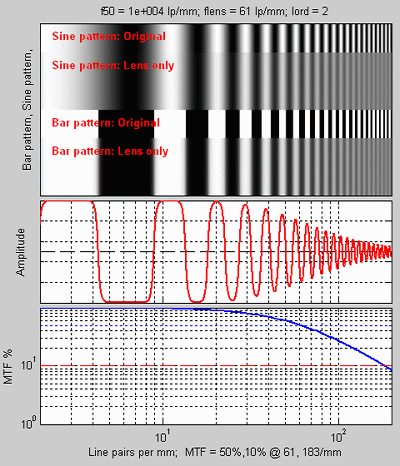In diving into film, trying to understand the resolution of film, I've started to better understand the different resolution terms and units that I have seen used by different review sites and what they mean.
A few good references, but here discusses the different units used to describe resolution, here is a good write up, and Imatest themselves have one of the best write ups I've seen on how to test resolution, cycles/frequency, MTF, etc and how it applies to photography.
So, just diving into this briefly, common terms are:
- Line pairs (LP): A pair of lines (
), but most easily thought of as a black and white line to show contrast.
- Line width (LW): The width of the dark or white line. 2 LW = 1 LP
- Pixels: Pixels are taken fairly idealistically and 1 row of pixels = 1 Line, so the width of a pixel = 1 LW = 1/2 LP
- Cycles: The distance (or time but for photography typically distance) to go from the start of a line pair to the end, so a cycle includes a complete dark line and a complete white line. Thus 1 cycle = 1 LP = 2 LW = 2 Pixel widths
- Dots does get a bit more complicated as dots can overlay each other, but when used for maximum resolution 1 dot = 1 pixel is typical.
- mm: millimeter, so unit of length
- in: inch, starting off easy here, another unit of length. 25.4 mm = 1 in
- PH: Picture height. Everyone treats this as obvious but I've yet to see someone report the picture height even when using the unit.
So, playing with a few values:
- 300 dpi = 300 ppi / 25.4 = 11.8 pixels per mm. Dividing that mm up: 1 mm /11.8 pixels = 0.0847 mm, or 84.7 micrometers/microns. As 2 pixels = 1 LP, 300 ppi is equivalent to ~6 LP/mm. This may sound easily obtainable, but if you are actually only resolving 60 LP/mm on a 36x24 mm sensor, you can only enlarge that image up to 360x240 mm (14x9.4 inches) before your true resolution drops below 300 ppi. 30 lp/mm, and 5x7 is the largest print you can do before dropping below 300 ppi.
- So, I am seeing good film is ~80 LP/mm. Playing with some math, the R5: 8,092 pixel/36mm / 2 pixels/LP = 112 LP/mm. Same math on R6 = 76 LP/mm theoretically possible.
- But, combining the lens on a camera body for an imaging system:
I would be very interested if anyone could confirm what Optical Limits means by PH. I did check several different reviews and it does seem like the peak observed at Optical Limits is typically 80-92% of theoretical on each of the different cameras they used (APS-C or FF). So, maybe PH being the sensor height in landscape orientation is the correct assumption, if not, it does seem to correlate somehow.
So, I know this is a bit of a dive, but I am finally putting together some of the math behind resolution, maybe connecting the dots between reviews I've read for years and what it might mean so I thought I'd share.
If correct, you can start to see just how much impact lenses are having on the resolution of camera bodies, very similar to what DXOMark does with their sharpness P-Mpix score.
Whew...ok. I know that was a lot. I don't view this as critical, but it is interesting and potentially helpful in understanding what lens/sensor combinations are capable. Also, the philosophies of digital vs film, digital is trying to make better and better lenses and subdivide the same 36x24 mm area smaller and smaller. So to get high resolution enlargements they need to continue to increase the lp/mm. Film, essentially took the opposite position, lens/film combinations seem somewhat fixed in the 30-80 LP/mm range, but if you want bigger enlargements, increase the size of your film.




 Reply With Quote
Reply With Quote

 that is in the works.
that is in the works.

